This Post May Contain Affiliate Links. Please Read Our Disclosure Policy.
Hey there, friends! I’m so excited to share this delicious Lemon Macarons recipe with you today. These French macarons are perfect for a springtime treat, and they’re not too difficult to make. With a little patience and practice, you’ll be baking macarons like a pro in no time! So what are you waiting for? Give this recipe a try and let me know what you think! These lemon macarons are filled with lemon buttercream and lemon curd making for one puckery bite!
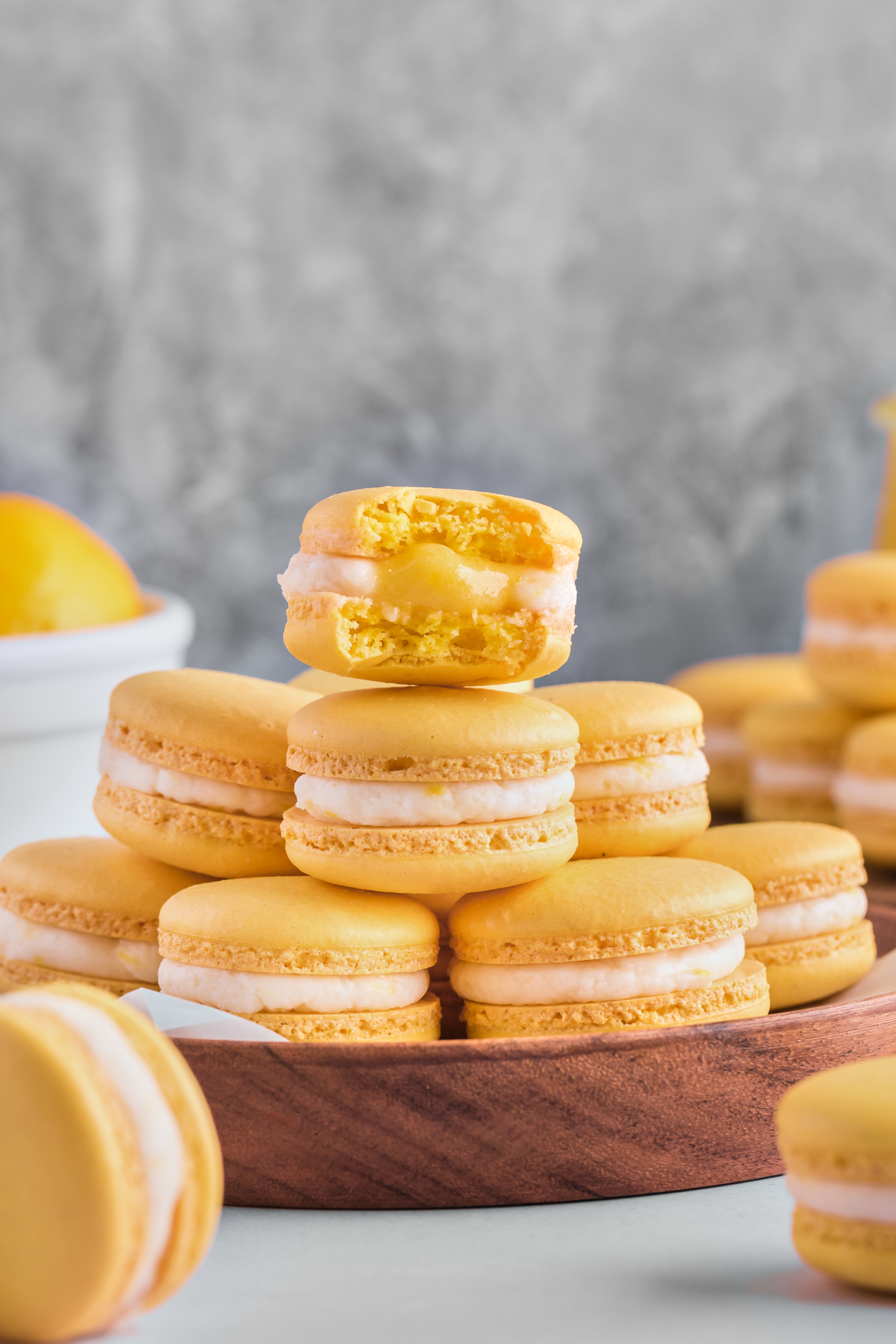
I love making lemon macarons with lemon curd because they’re so light, airy, and delicious. The combination of the tart lemon curd and the sweet buttercream frosting is simply irresistible. I also love the way the French macarons look. The smooth, shell-shaped cookies are so beautiful and perfect, and they make me feel like a professional baker every time I make them.
I’ve been making macarons for years, and I’ve learned a few things along the way. First, it’s important to use good-quality ingredients. Using high-quality almond flour will make a big difference in the taste and texture of your macarons.
Second, make sure your egg whites are at room temperature before you start. This will help them whip up to their full potential and create a light and fluffy batter. Third, don’t overmix the batter. Overmixing will make the macarons tough and create hollow shells.
I also love that lemon macarons are a versatile dessert. They can be enjoyed for any occasion, from a casual afternoon tea to a formal wedding reception. Perfect for Easter, Mother’s day or just a wonderful summer time treat!
They can also be customized to fit any flavor profile. For example, I’ve made lemon macarons with vanilla frosting, strawberry buttercream frosting and even with some fresh raspberries inside. This lemon macaron recipe however is lemon all the way – they have a lemon curd filling and lemon buttercream.
If you’re looking for a delicious and challenging baking project, I highly recommend trying lemon macarons. They’re sure to become a new favorite!
See Also:
- Make these Chocolate Bailey’s macarons for the holidays! They’re a perfect treat for St. Patrick’s Day!
- Enjoy Boston Creme pie macarons with a vanilla macaron shell dipped in ganache and a vanilla pastry cream in the middle.
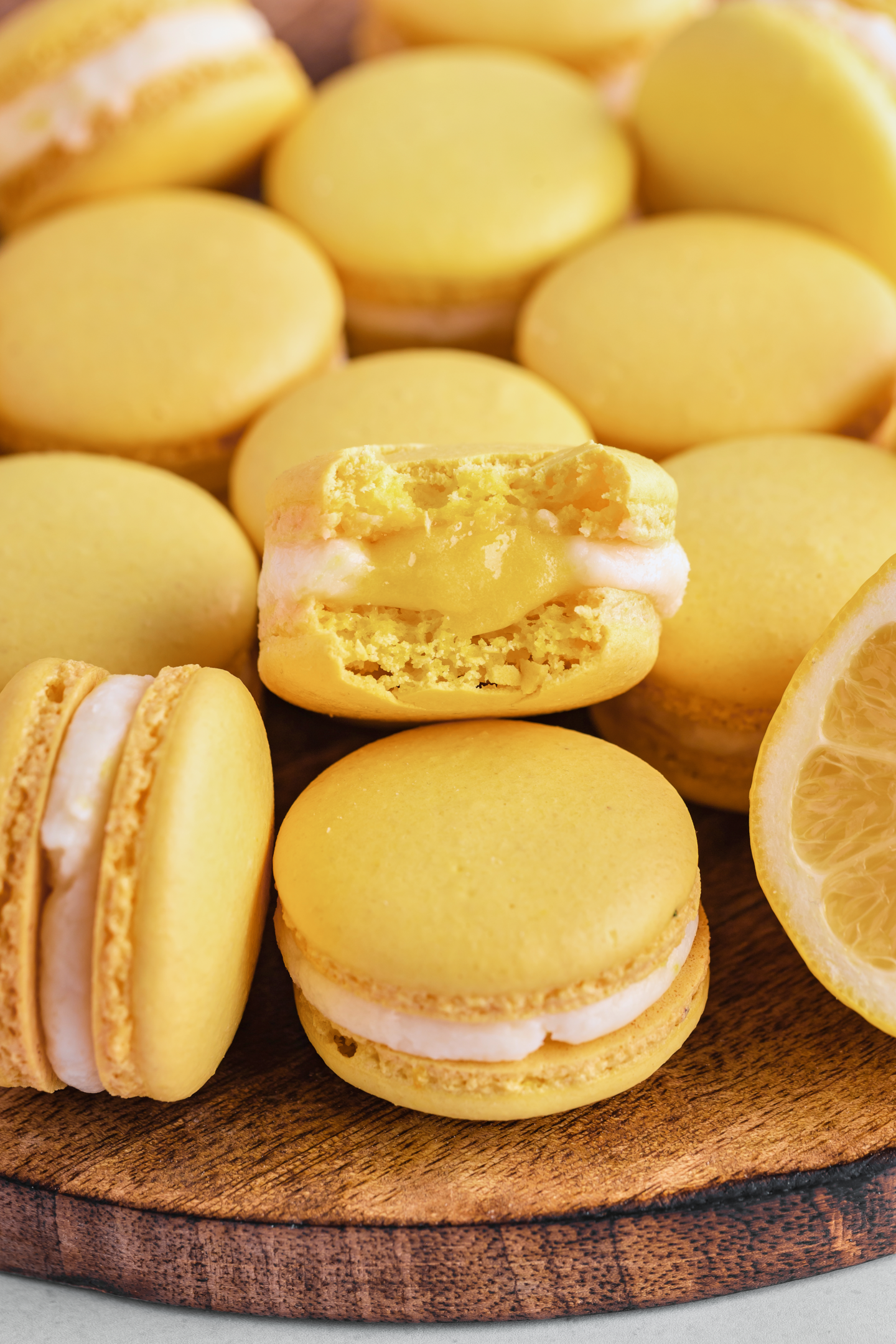
Why You Will Love Lemon Macarons
- Lots of Lemon Flavor. If you love the taste of lemons, then you will love this recipe! This isn’t a plain macaron recipe! It includes the lemon macaron shells, lemon curd, and lemon buttercream to complete the lemon macaron recipe! To achieve this lemon-y flavor, you’ll need fresh lemon juice and lemon zest. If needed, you can use lemon extract instead.
- They are delicious: Lemon macarons are a light and airy cookie with a tart and sweet lemon flavor. They are the perfect treat for a springtime afternoon tea or a special occasion.
- They are beautiful: Lemon macarons have a smooth, shell-shaped appearance that is both delicate and elegant. They are sure to impress your guests. I love lemon macarons filled with lemon curd and I even added lemon buttercream!
- They are relatively easy to make: Lemon macarons are not as difficult to make as you might think. With a little practice, you can easily make these delicious treats at home.
My Recommended Tools
 Buy Now →
Buy Now →  Buy Now →
Buy Now →  Buy Now →
Buy Now → 
Ingredients Needed
For Macaron Shells Recipe:
- Egg Whites- You will need to separate the yolk from the egg whites. The yolks are used in the curd. You do not need to age the egg whites. This recipe can be made with egg whites straight from the refrigerator. I do not recommend using egg whites from the carton, they do not produce a strong enough meringue.
- Cream of Tartar- To stabilize the egg whites and prevent overbeating. Don’t skip it!
- Sugar- I used granulated white sugar.
- Almond Flour- For this recipe we will use almond flour. Macarons are made with almond flour and cannot be substituted with regular wheat flour. Recommended almond flour: Blue Diamond (best choice) or Costco almond flour (second choice). Both of these almond flours are already finely sifted and provide the best texture for this macaron recipe.
- Food Coloring (Gel or Powder)- It’s best to use gel food coloring or powder, and not liquid food coloring which can add too much liquid to your batter affecting the consistency of your macaron batter.
For Lemon Buttercream Recipe:
- Butter- I prefer unsalted butter at room temperature
- Lemon Juice- Fresh-squeezed is best, but store-bought works fine too
- Lemon Zest- For additional lemon flavor
- Powdered Sugar- You need confectioners sugar (or powdered sugar) for the buttercream frosting. I don’t sift my sugar anymore but just make sure to whip it long enough.
- Heavy Cream- To thin out your frosting and add a bit of richness and creaminess. But milk also works
- Salt- Just a pinch of salt to balance the sweetness!
For Lemon Curd Recipe:
- Egg Yolks- If you need help separating the yolks from the egg whites, check out my post on 6 different ways to separate them
- Butter- The butter for the curd should be cold from the refrigerator
- Lemon Juice- For lemon flavor
- Granulated Sugar
- Salt- Just a pinch of salt!

How to Make Lemon Macarons
Wipe bowls, Attachments, Spatulas, and Mats with White Vinegar.
Before starting, wipe down bowls, attachments, spatulas, and baking mats with vinegar to eliminate any grease or residue. This is essential to help make sure your lemon macarons come out correctly.
Prepare Macaron Batter for Macaron Shells:
Sift Almond Flour and Powdered Sugar.
Sift together the almond meal and powdered sugar into a medium bowl. Set almond flour mixture aside.
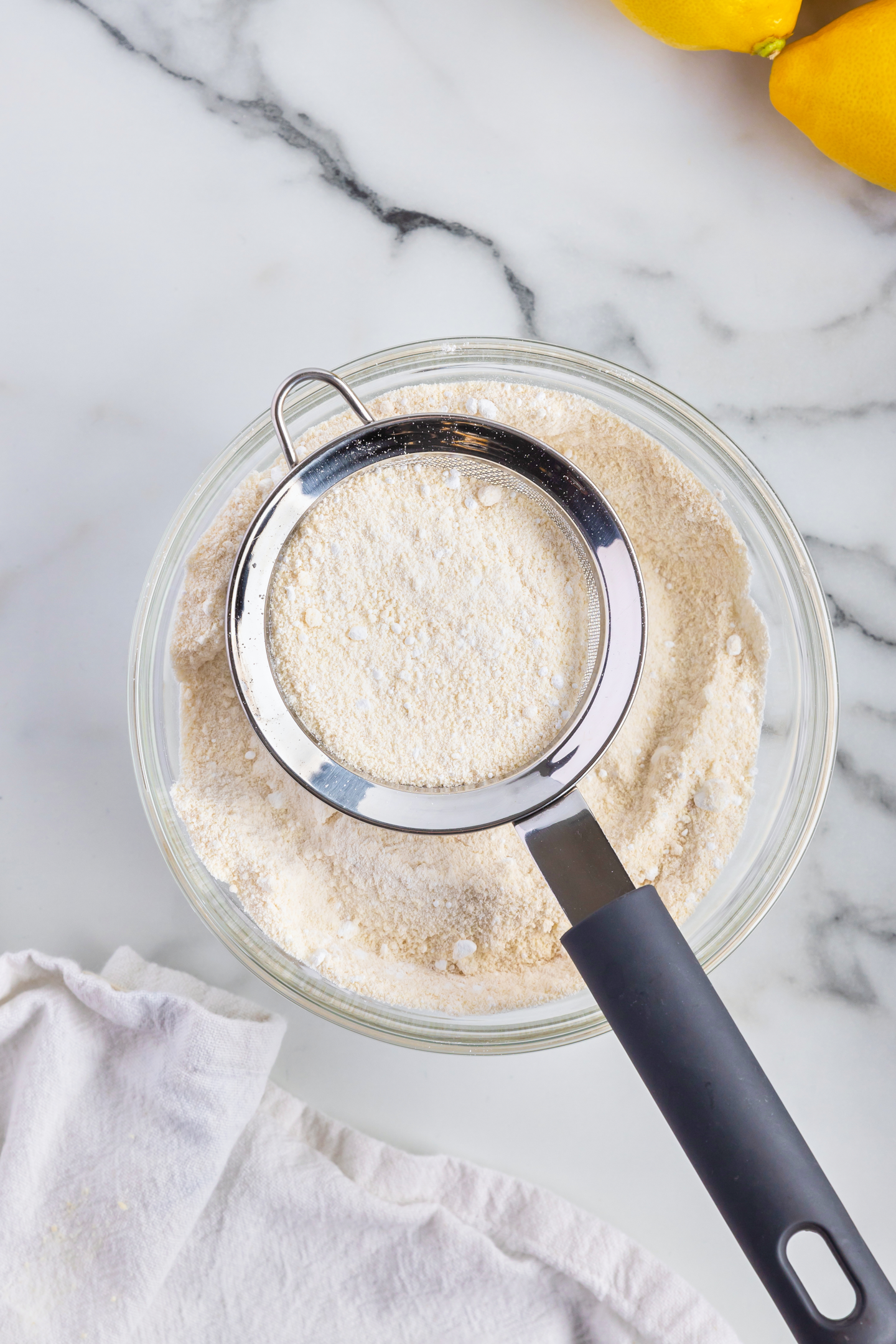
Mix Sugar, Egg Whites, and Cream of Tartar.
Then in your stand mixer you want to combine the granulated sugar and add your room temperature egg whites and cream of tartar. They will start out foamy but the more you mix it will start to mix up to full volume and stiff peaks.
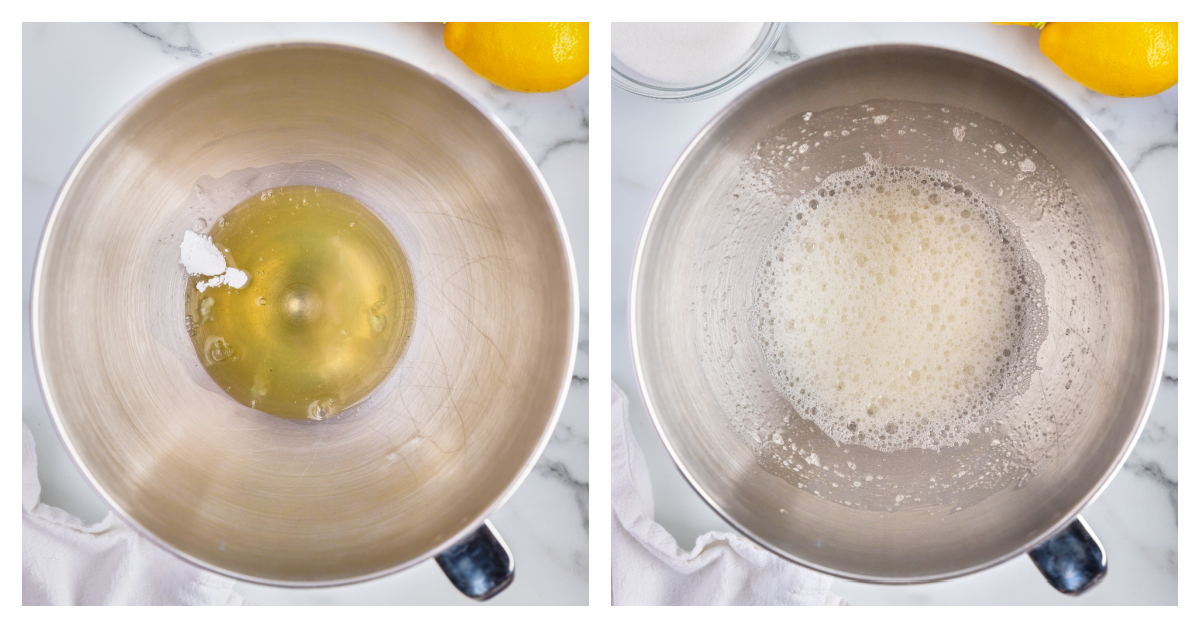
Make sure there are no egg yolks present in the egg whites so they whip up to full volume. (For help on separate your eggs cleanly, read how to separate eggs.) Make sure to not overmix! You need to whisk your egg whites, granulated sugar, and cream of tartar on medium speed until the meringue is glossy and forms stiff peaks. It takes about 11 minutes to form stiff peaks. Basically, it’s going to look like a giant cloud of marshmallow fluff when you form stiff peaks.
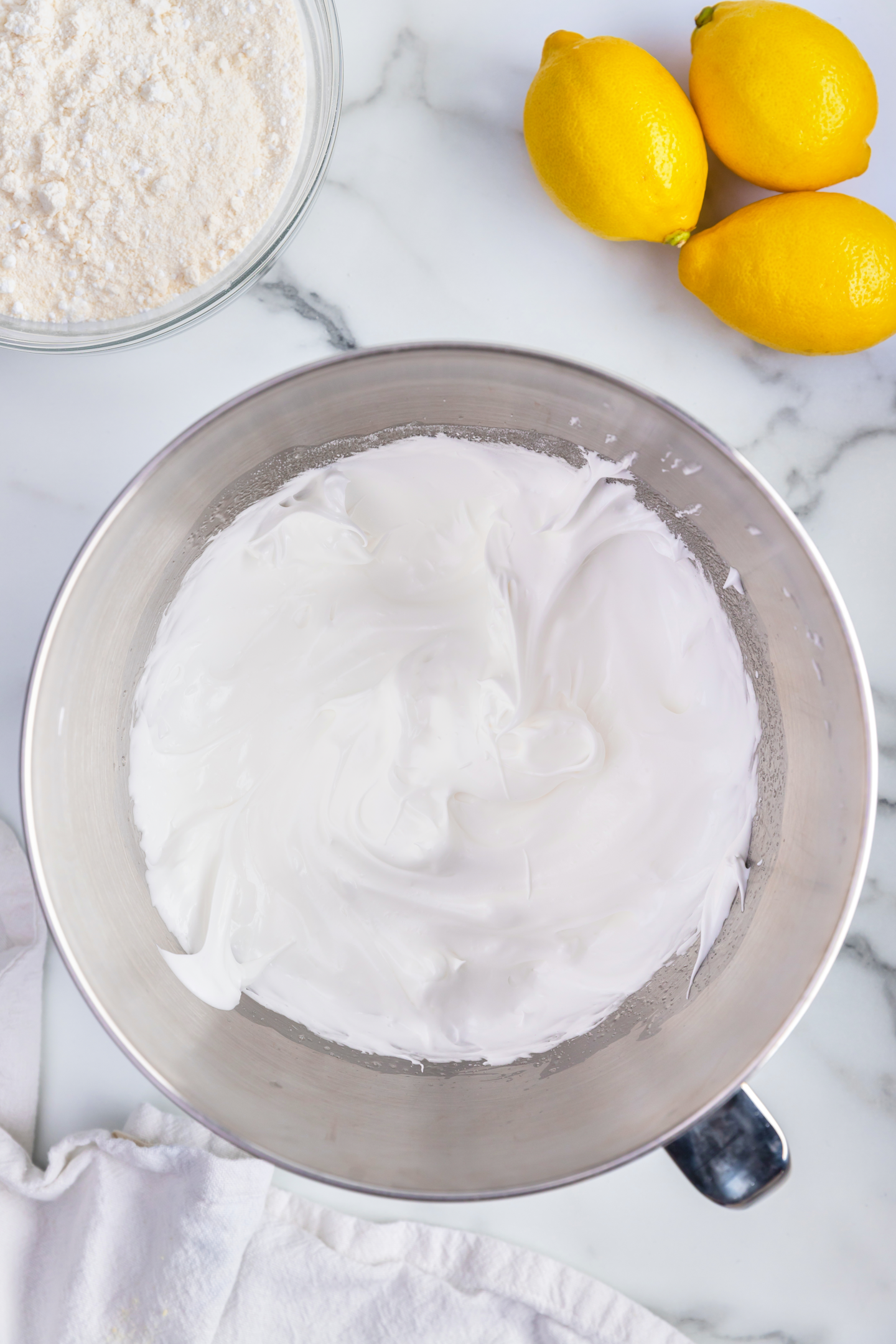
Begin the macaronage process:
Sift Dry Ingredients and Fold.
Preheat the Oven to 300F degrees. Combine sifted powdered sugar and almond flour with wet ingredients, and begin to fold into the meringue.
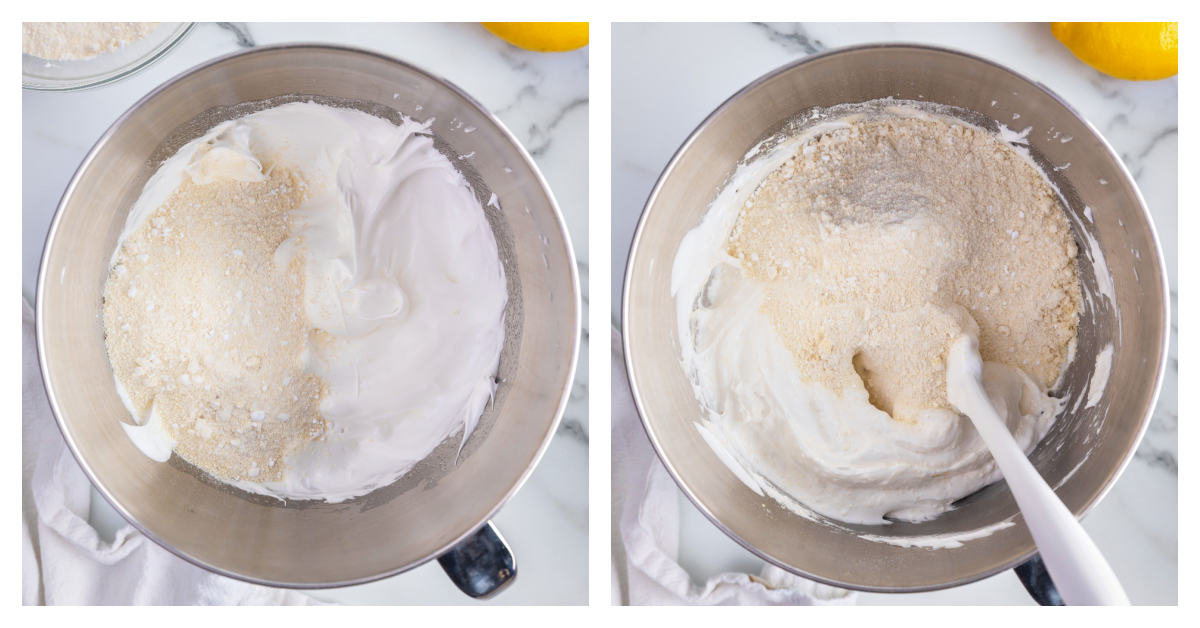
The macaron batter should run off your spatula when you hold it up into a ribbon. Deflate some of the air in the meringue so it will not become a hollow shell. If you pick up your spatula, and the batter does not flow off of it, the macaron batter is still too thick, so continue to keep folding. Another way to test is to see if the macaron batter is at the right consistency, is the Figure 8 Test. You want to see if you can draw a figure 8 in the macaron batter.
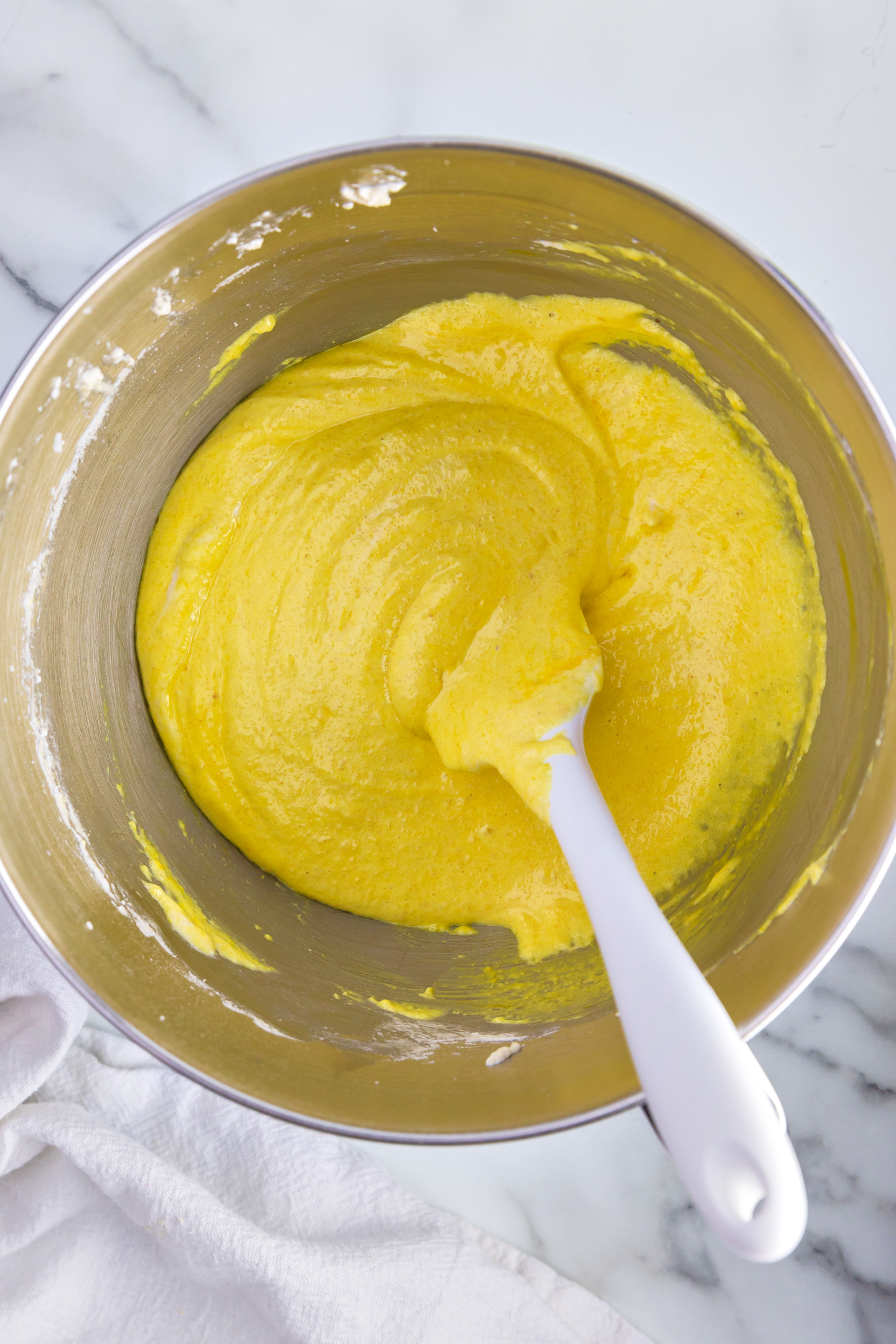
Pipe Shells.
To pipe the macaron shell, I used a 1/2-inch round tip like this one. I pipe my macaron shell onto a macaron mat instead of normal baking sheets. These silicone baking mats have circle templates, so it makes for easier and more even piping.
If you’re new to macaron making, the mat makes things so much faster. If you don’t have a macaron mat, you use a macaron template. I found this template at Barbara Bakes.
While you are piping, you want to cover the meringue that is still in the bowl with plastic wrap so it doesn’t dry out.
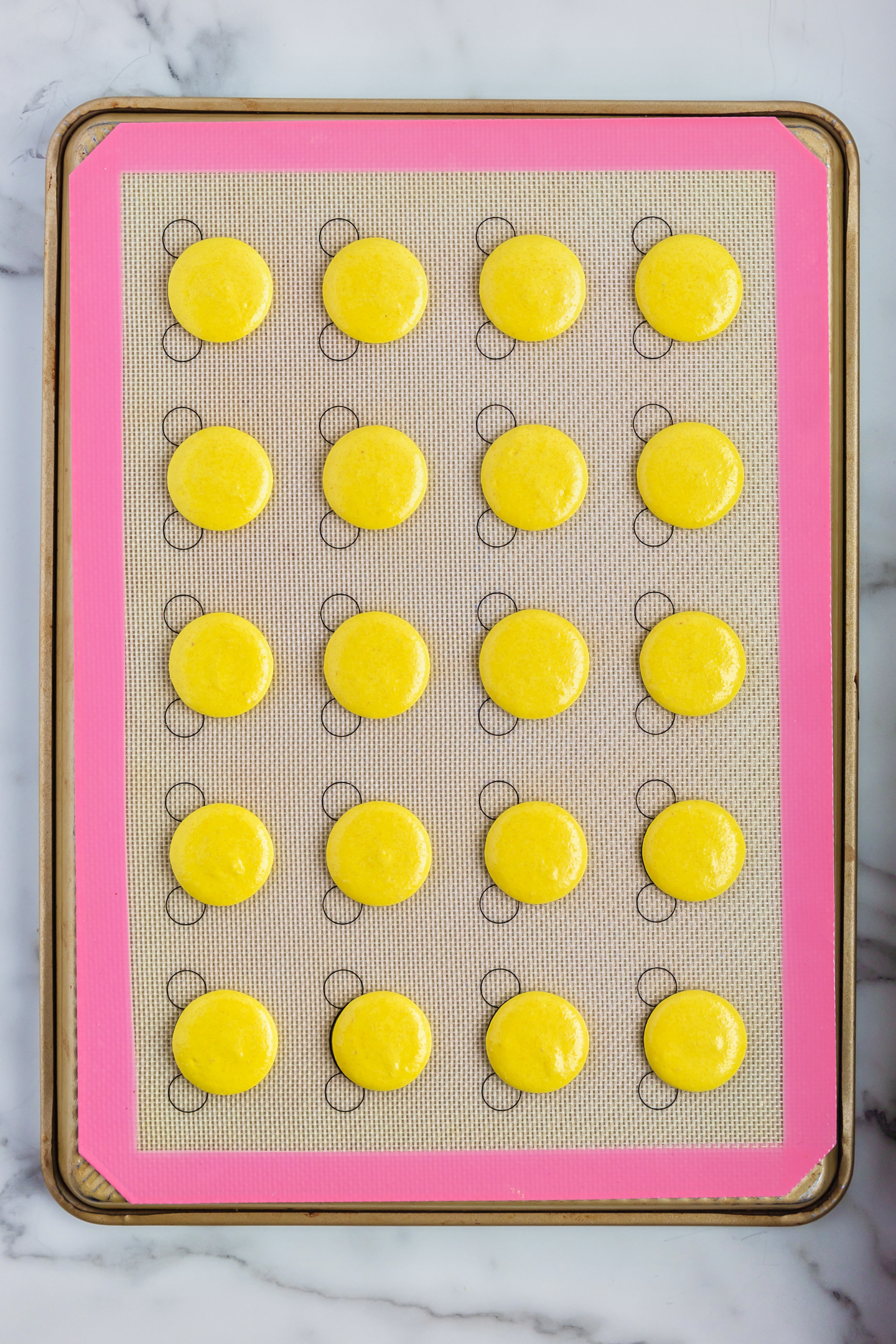
Eliminate Air Bubbles.
After you pipe your shells of macaron batter, you want to firmly slam the baking mat or baking sheets down on your countertop to remove excess air. If there are any air bubbles, just take a toothpick and pop them.
Allow Shells to Form Skin.
Once your shells are piped you need to let them dry out. Let the shells rest at room temperature for 30 minutes to an hour, until they form a skin. You can tell they are ready, when you touch one and it’s dry. By letting the shells rest, this will help in developing the feet when they bake.
Bake.
Bake shells in oven at 300°F for about 12-15 minutes, until the feet of the shell feel firm and the shells just come off the mat. Then let them dry on a cooling rack for about an hour before filling them.
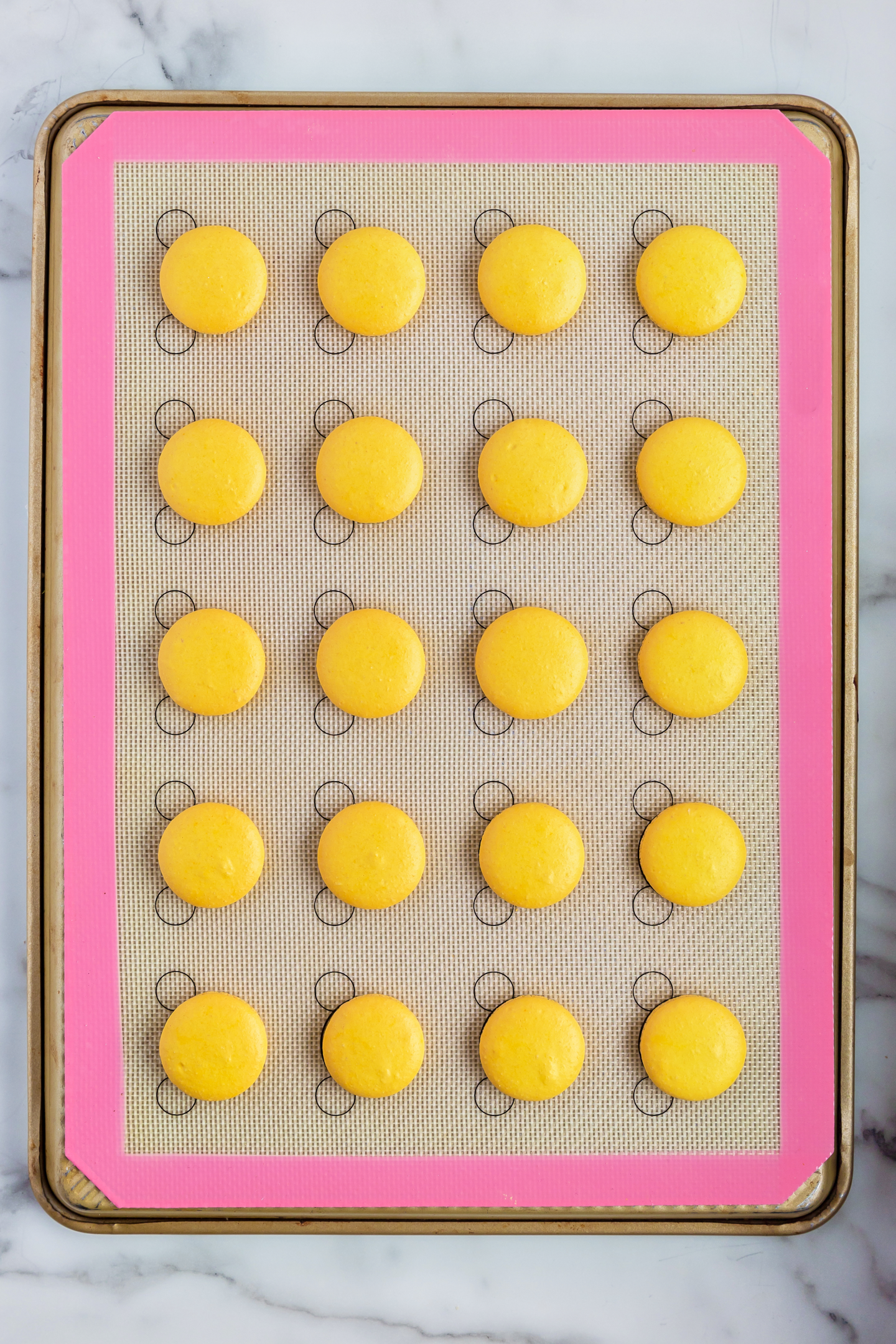
Allow Macarons to Cool.
Remove from the oven and allow macarons to cool completely on the mat. Do not remove until completely cooled (about 15 minutes). It is very important that they cool completely.
Prepare Lemon Curd.
Zest Lemon.
While the macarons are baking, start preparing the lemon curd. Zest lemons until you have one tablespoon of zest.
Add Lemon Zest and Sugar.
Add lemon zest and sugar to a small food processor or blender. This helps extract oils from the zest and create a lot of lemon-y flavor for the lemon curd!
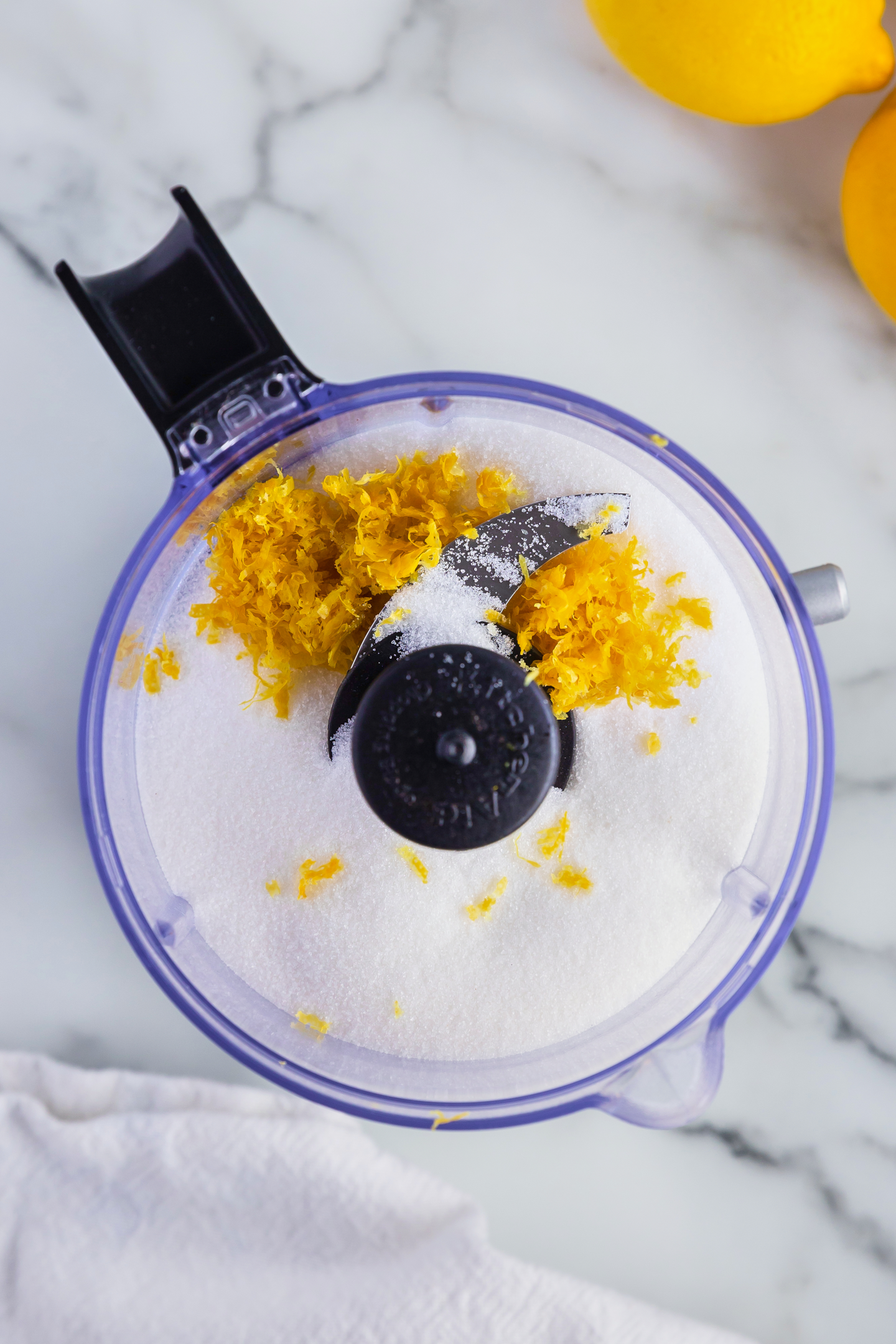
Add Egg Yolks, Lemon Zest and Sugar.
In a small pot, whisk egg yolks, lemon zest, and sugar until they are lighter in color. It may take a few minutes depending on how fast you are whisking.
Add Lemon Juice.
Continue to whisk and add one tablespoon of lemon juice at a time until it is all added and well combined to the lemon curd mixture.
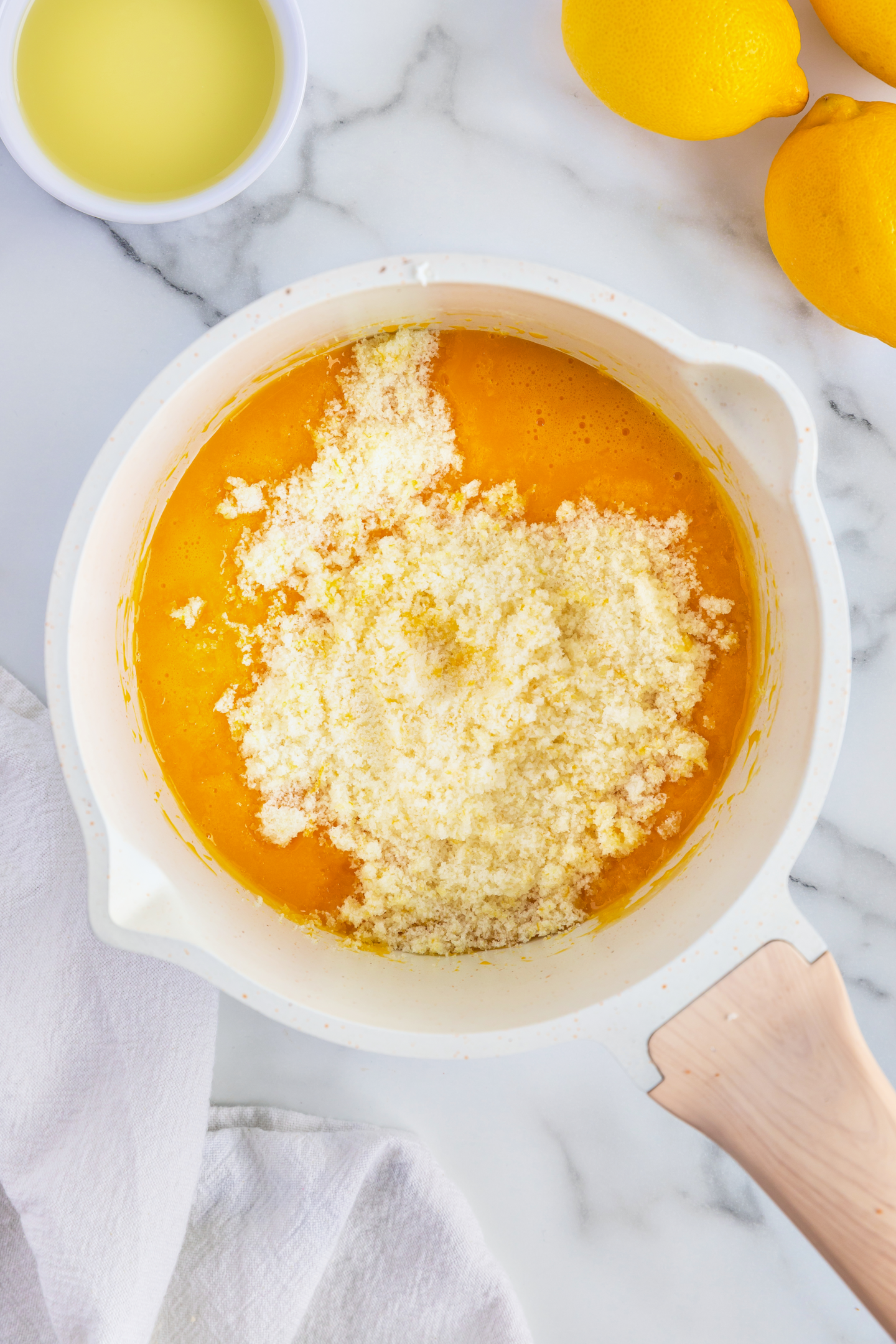
Heat Mixture.
Turn the stove to low heat and continue to whisk until the mixture thickens. It will be done when it starts to bubble and can coat the back of a wooden spoon. Remove the pot from the heat.
Add Butter.
Cut up the butter into cubes. While continuing to whisk, add the butter slowly one piece at a time. Add the next piece when the previous piece has completely been incorporated. Continue to do this until all the butter is added.
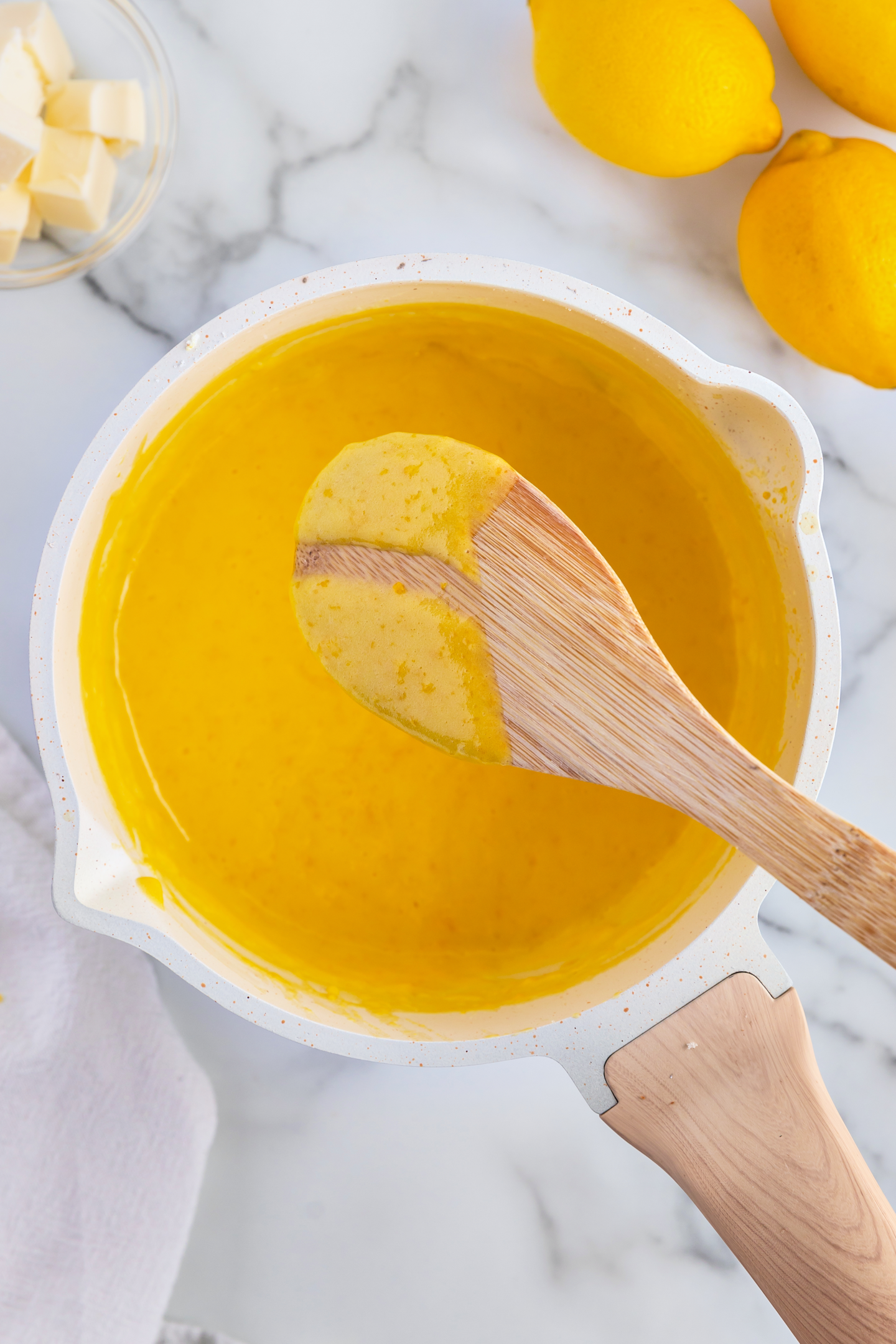
Allow Lemon Curd to Cool.
Transfer the lemon curd to a jar or storage container. Allow to cool to room temperature and then store the lemon curd in the refrigerator. Be sure to add plastic wrap directly to the top to avoid skin forming on top of the lemon curd.
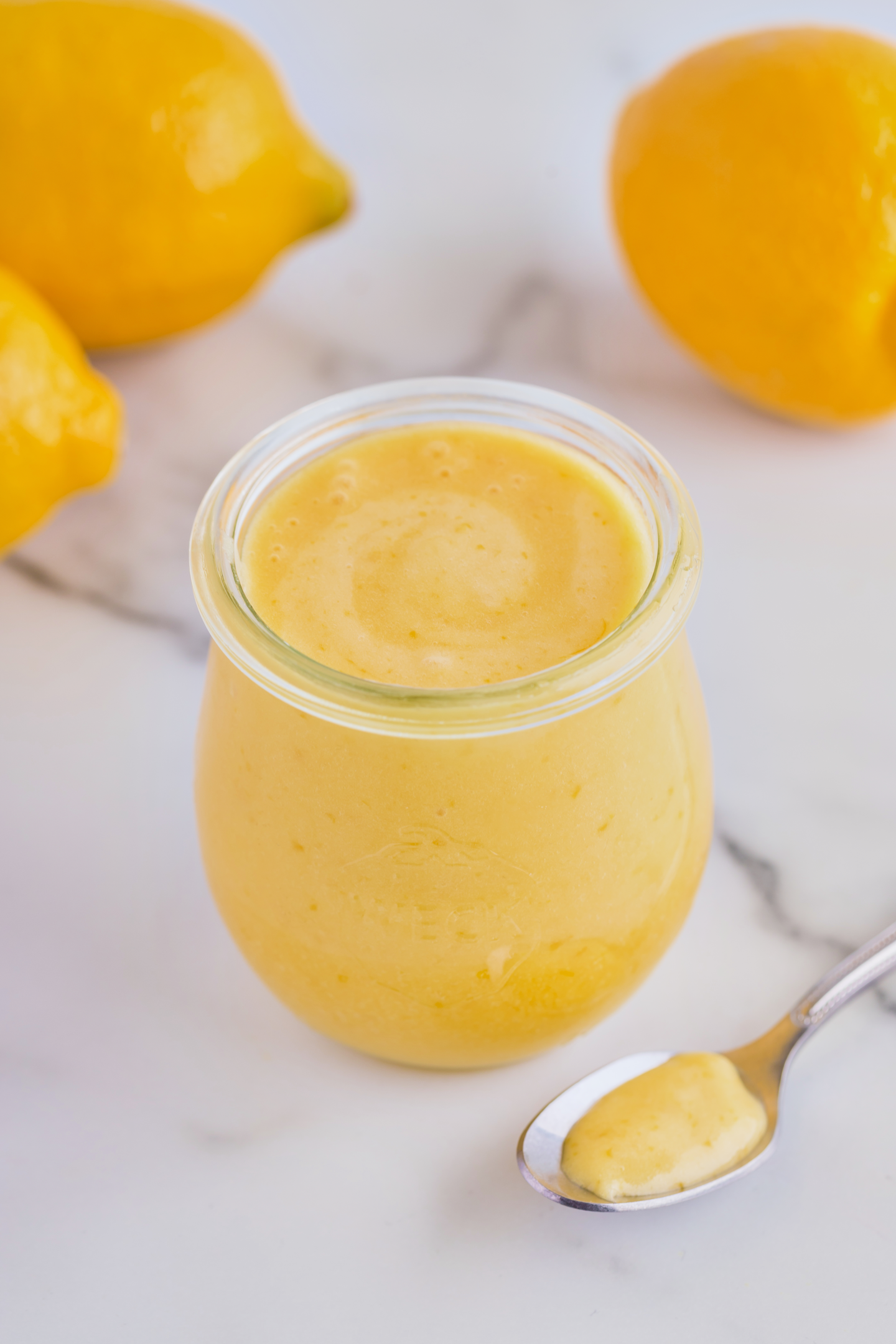
Make the Lemon Buttercream For Macarons.
Beat Butter.
In a medium bowl, beat the butter with an electric mixer on medium-high speed until light and fluffy, about 2 – 3 minutes.
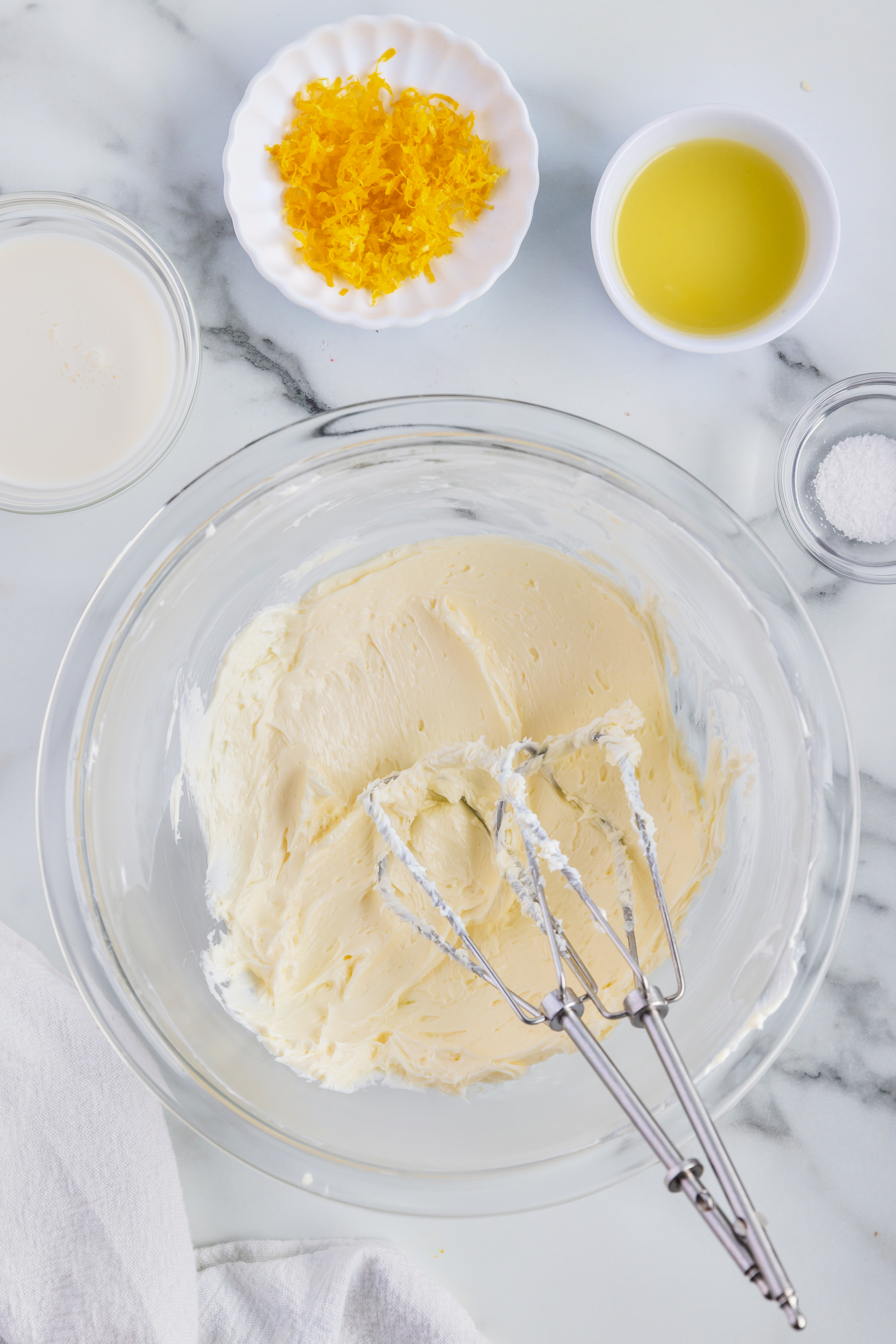
Add Lemon Zest, Lemon Juice, Salt, and Half of the Sugar.
Add the lemon zest, lemon juice, salt and half the powdered sugar, and beat on low speed until fully incorporated for about 1 minute.
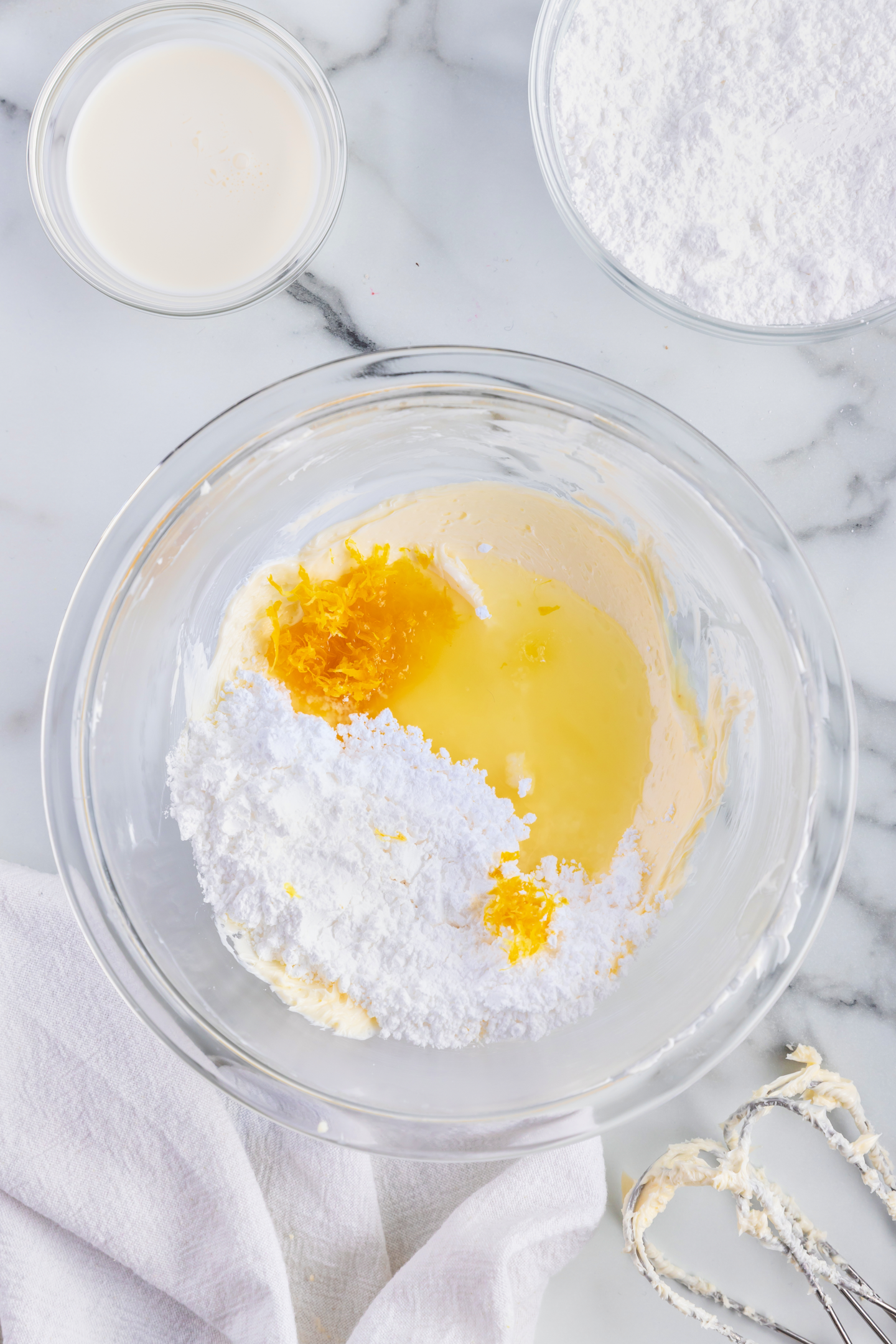
Add Remaining Sugar and Heavy Cream.
Add the remaining powdered sugar and 1 tablespoons of heavy cream. Mix together again until the ingredients are incorporated. If the lemon buttercream is too thick, add an additional tablespoon of the heavy cream until it reaches a creamy consistency. If too think, add a couple of tablespoons of powdered sugar.

Prepare Piping Bag.
Put the lemon buttercream in a piping bag with a piping tip (A size 10 or 12 piping tip will work best). You can also put the lemon curd into a piping bag or use two spoons to carefully dollop onto the macaron shells. If using a piping bag, you do not need to put a tip on, I just cut the end of the bag and easily pipe it into the center of the macarons.
Fill Lemon Macarons.
Before filling the lemon macarons, match each up into pairs of macaron shells similar in size. Take one macaron shell and do a circle of lemon buttercream. In the center, add the lemon curd and then sandwich it together with the matched macaron shell.
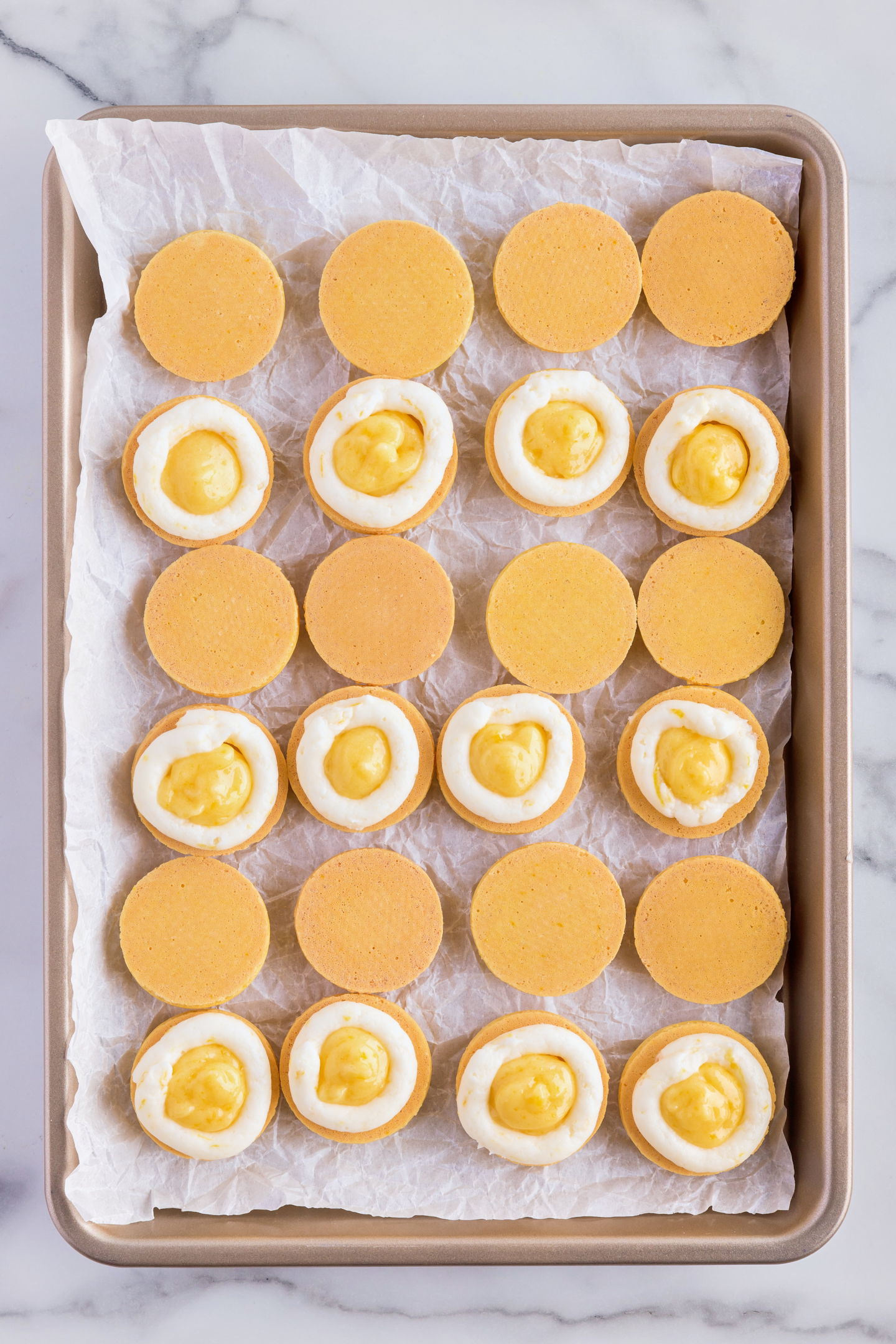
Refrigerate.
Allow lemon macarons to mature for at least 24 hours in the refrigerator. Bring to room temperature for 30 – 45 minutes before eating them.
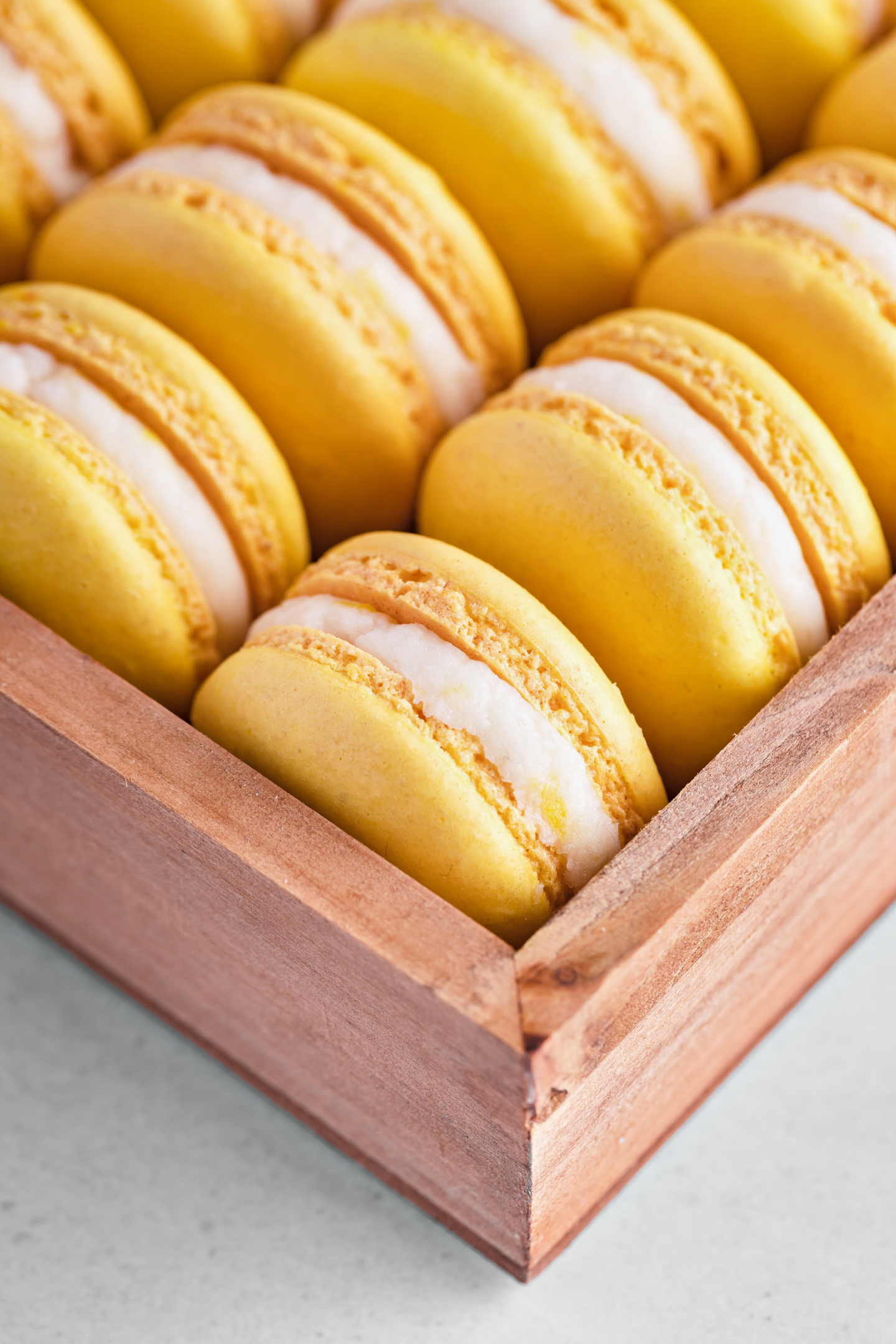
Recipe Tips
- Separate eggs one at a time. I separate my eggs one at a time and add each egg white to my mixing bowl. That way if I do get any egg yolk in an egg white, I haven’t ruined all of my egg whites.
- Separate eggs while cold. Cold egg whites are easier to separate.
- Whip room temperature egg whites. Room temperature egg whites will whip up faster and to a better volume than cold egg whites.
- White vinegar – Vinegar is used to wipe down bowls, spatulas, and baking mats to remove any oil residue. This is not included in the photo as it does not go in the recipe, but I recommend not skipping this step. It helps to ensure that the lemon macarons will form correctly.
- Sift the dry ingredients well. It’s important for the consistency of your lemon macarons that you sift the almond flour to get rid of any larger pieces of almond. You can also pulse the almond flour in a food processor to make sure it is super fine.
- Make sure to eliminate air bubbles. Don’t skip the step of banging the pan or mat on the counter. This helps get rid of all the air bubbles. This will ensure even rising as the lemon macarons develop “feet.”
- Use a stand mixer. A stand mixer will come in handy for the egg whites and powdered sugar when you are making the macaron shells.
- Flip the baking sheets upside down. You want to flip your baking sheets upside down. I know this sounds weird, but this helps provide better airflow to the macarons and more even baking.
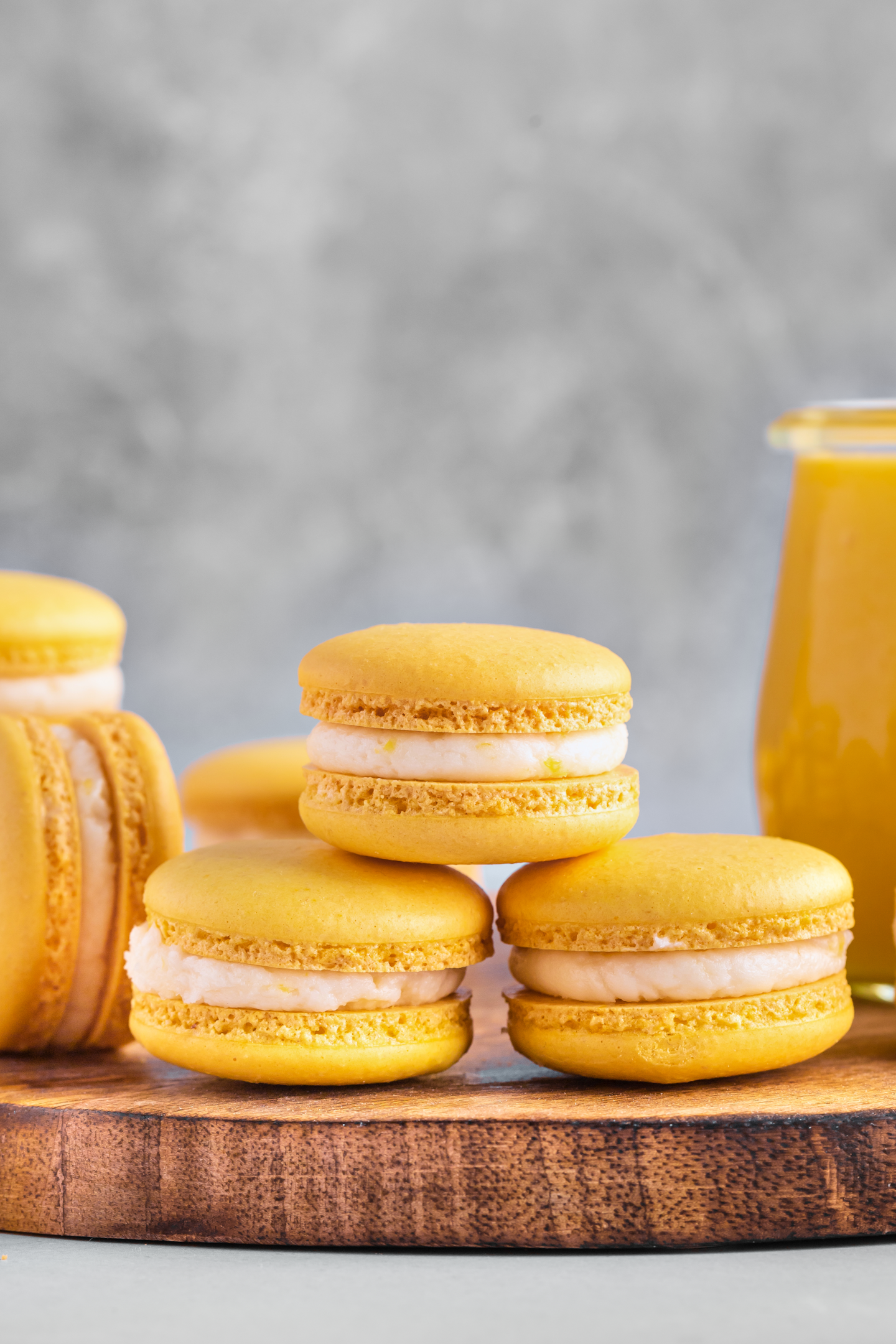
Recipe Variations
- Raspberry. Add a few drops of raspberry extract to the buttercream. Or a fresh raspberry in the middle!
- Change the filling. These macarons are filled with lemon curd, but you could change up the filling! You could make raspberry curd, strawberry buttercream frosting, or just a really good vanilla frosting.
- Add Vanilla. If you wanted to add more of vanilla flavor to the buttercream, you can add vanilla extract.
- Use Lemon Extract. If you can’t use fresh lemon juice or lemon zest, you could replace these ingredients with lemon extract.
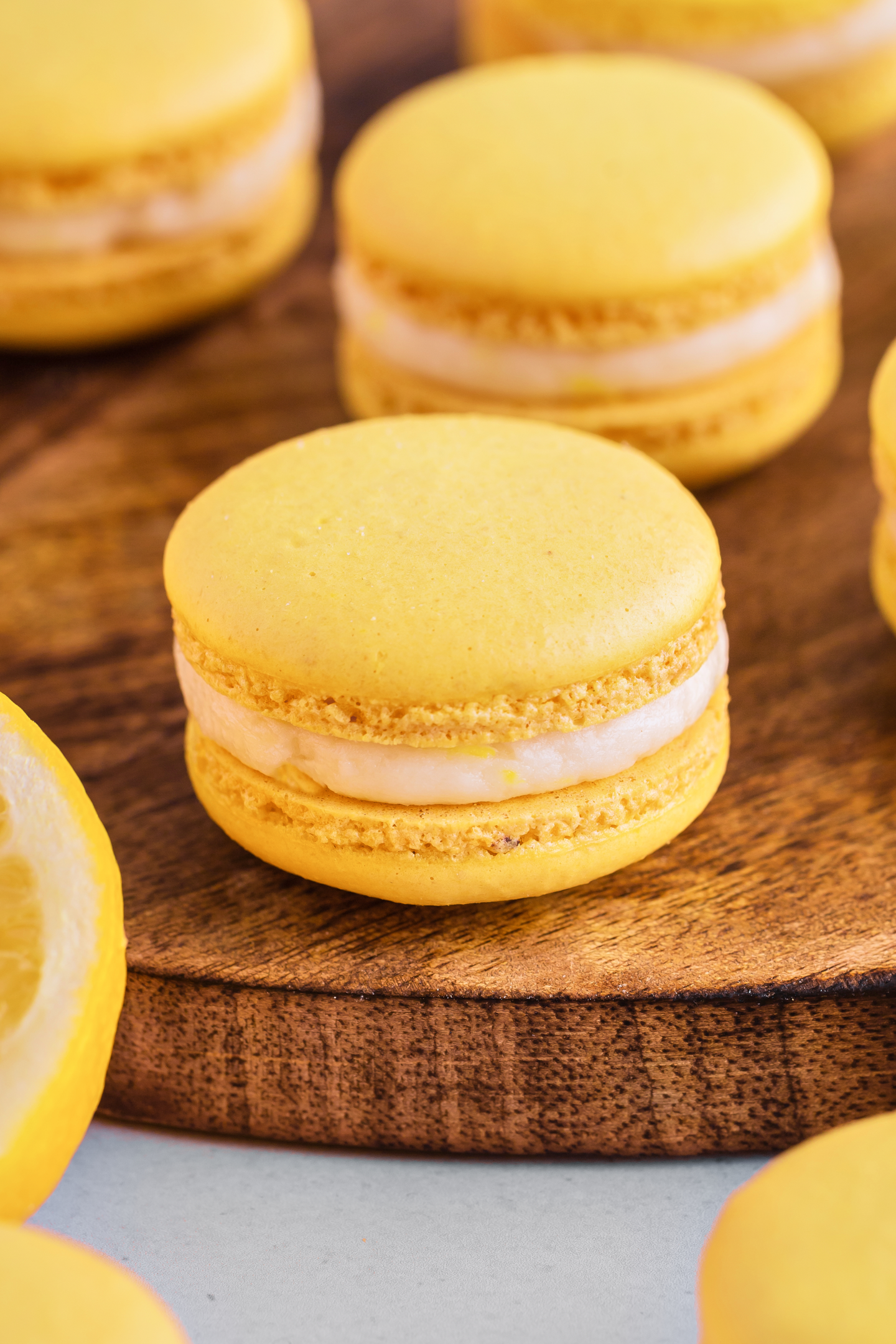
Recipe FAQs
You can store your macarons in an airtight container in the refrigerator for up 5 days. You do not want to freeze filled macarons. I would not store them in a bag. These cookies are very delicate and can break easily. I recommend an air-tight container.
Macarons filled with lemon curd don’t freeze well. They become too moist when they defrost.
You can, but macarons need to mature for at least 24 hours in the refrigerator for the best taste and flavor. In a pinch, I have done the following method to speed along the maturing process for macarons. Take a small amount of heavy cream or milk and brush it on the inside of the shells. This does not need to be a lot, just lightly brush it on the shells (you don’t want super soggy shells and you want the filling of the shells to do most of the maturing process). Then proceed to fill your macarons as usual. Let the shells mature at room temperature for a few hours. I find they are usually mature within about 4 – 5 hours. Again, letting them mature in the refrigerator is best, so use this method cautiously.
No, but you certainly can if you want to. I have made these with egg whites that are straight from the refrigerator. I usually measure them first so that they a room temperature when starting the meringue. I don’t recommend using egg whites from the carton.
Almond flour is what makes a macaron. Sometimes macarons can be made with different nut flour or all-purpose flour, but I have not done enough testing to verify they would be successful with this recipe.
The macaron shells are gluten-free. The ingredients in this recipe should all be gluten-free, but be sure to double-check your labels.

Macaron Troubleshooting
Why don’t my macarons have feet?
There could be many reasons why your macarons don’t have feet. There could be excess oils or moisture in the batter (this is why we use white vinegar to clean everything beforehand), weak meringue, a humid environment, your shells did not rest long enough, or the oven temperature was too low.
Why did my macaron shells crack?
Macarons are really picky. Any small misstep can cause problems for the final product. Shells can crack because of weak meringue, overwhipped meringue, or oven temperatures that are too high.
What if my macaron shells spread too much?
This is usually from either over-mixing or the oven temperature being too high. If they spread a lot when piping them, they were likely over-mixed. If they spread a lot during baking, try decreasing your oven temperature.
What if my macaron shells don’t develop feet?
This can also happen for a number of reasons. Humidity or the possibility these needed more time to dry. You also might have an oven temperature that is too low. You could try increasing the temperature by 10 – 20 degrees. Try changing one of these things, but don’t try changing everything. Even without feet, these will still be tasty to eat.
What if my macaron shells are hollow?
There is an obsession on the internet for full shells, so please don’t fret if you get them. Your macarons are perfectly fine and will still taste amazing. Also, once you pipe the filling and let them mature, the hollow part should fill in more and you hardly notice them being hollow.
What if my shells are lopsided?
This can happen if you are not piping your batter correctly. Make sure when you are piping the batter that it is straight down and not at an angle.
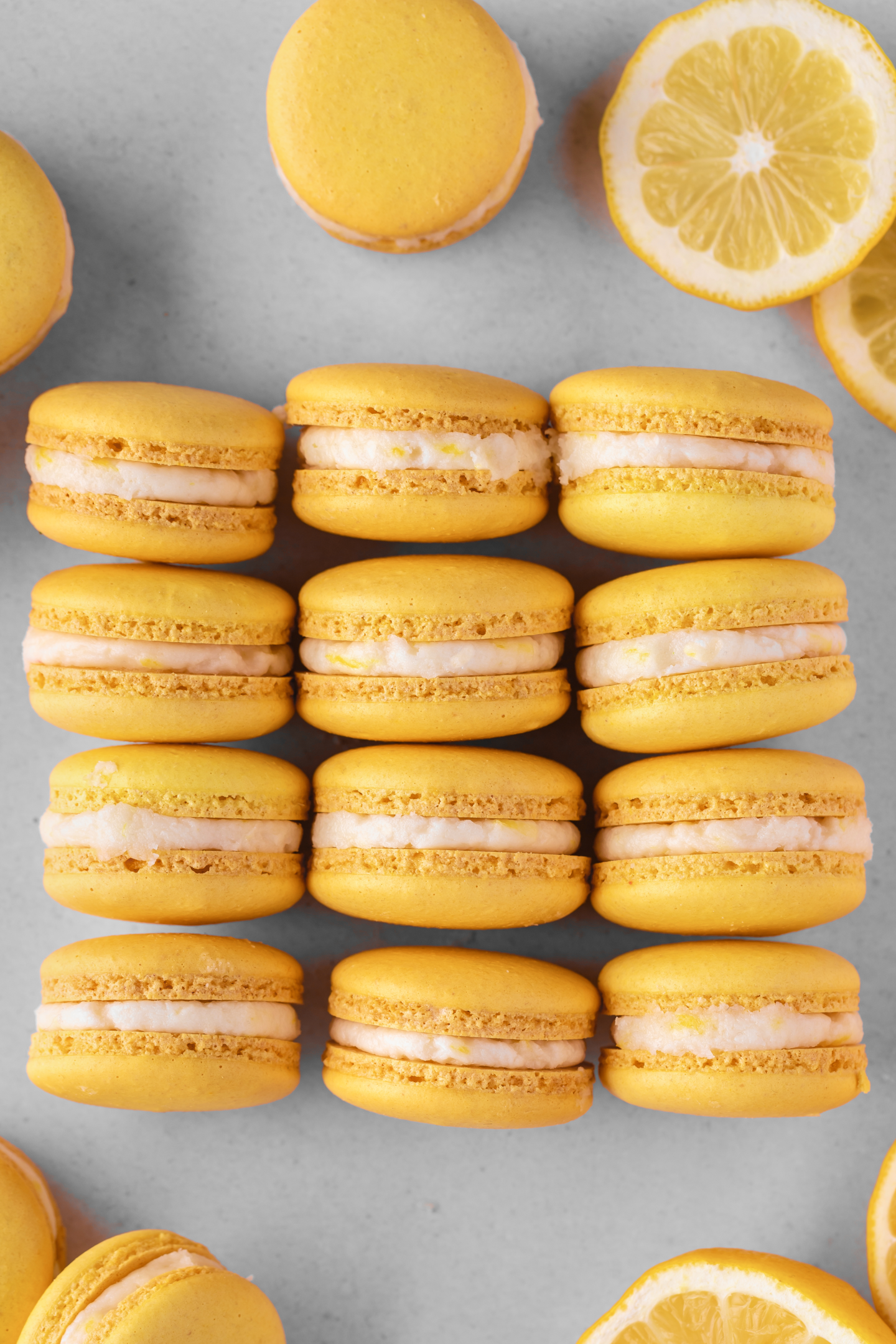
More Recipes to Try

Lemon Macarons
Equipment
- silicone baking mat
Ingredients
Macaron Shells
- 105 grams egg whites
- ¼ teaspoon cream of tartar
- 105 grams granulated sugar
- 140 grams almond flour
- 125 grams powdered sugar
- Food coloring – either gel or powder
Lemon buttercream
- ½ cup (1 stick, 113 g) unsalted butter room temperature
- 1 tablespoon fresh lemon juice
- 1 tablespoon grated lemon zest
- 1 ½ – 2 cups (113-170g)powdered sugar
- 1-2 tablespoons heavy cream
- ¼ teaspoon Kosher salt or a pinch of table salt
Lemon Curd
- 3 large egg yolks
- 1/2 cup (50 g) granulated sugar
- 3 tablespoons lemon juice
- 1 Tablespoon lemon zest
- Pinch of salt
- 4 tablespoons unsalted butter cold from the refrigerator
Instructions
Make the lemon macarons
- Before starting, wipe down bowls, attachments, spatulas, and baking mats with vinegar to eliminate any grease or residue. This is essential to help make sure your macarons come out correctly.
- Sift together the almond meal and powdered sugar into a medium bowl. Set bowl aside.
- Add the egg whites and cream of tartar to the bowl of a stand mixer. Turn on the stand mixer on low and mix the egg whites until foamy for 2 – 3 minutes.
- With the mixer running, slowly start to add the granulated sugar to the egg whites. Once all the sugar has been added, increase the stand mixer speed to medium speed and continue to mix until your meringue reaches stiff peaks. This takes around 6 – 7 minutes, but be sure to check it often to avoid over-mixing.
- Once the meringue is done, remove the mixing bowl from the stand mixer.
- Remove the mixing bowl from the mixer.
- Begin the macaronage process. Add half of the powdered sugar/almond meal mixture to the egg whites. With a large flexible spatula fold until combined. Then add the remaining mixture. Once almost combined, you can add the food coloring. (Be sure to do it early on in the macaronage process to avoid overmixing. Also, you can food coloring during the meringue mixing, but the color may be lighter. I like adding color during macaronage to get brighter and more colorful shells.)
- Continue mixing by scraping the batter against the side of the bowl. The batter is done being mixed once the batter flows in ribbons off the spatula. Test the batter for doneness by trying to make a figure 8 with the batter while is it falling off the spatula into the bowl. It’s done if the ribbon does not break. Be careful not to over-mix. Be sure to complete this process with both bowls.
- Line an upside-down baking sheet with silicon baking mats, preferably ones with circle templates for macarons.
- Fill a piping bag with a round piping tip with the batter. Pipe the batter on the baking mat following the template on the mat. Once done piping, carefully rap or bang the pan on the countertop to get rid of any air bubbles. Using a toothpick or scribe, pop any air bubbles. Quickly then top with the crushed fruity pebbles on the macarons.
- Preheat your oven to 300°F (150°C). Please note you may need to adjust your temperature down if your oven bakes on the warmer side. Don’t be afraid to go down to 295 or 290 degrees if needed. If you decrease your temperature then you may also need to adjust the bake time to add another minute. (Note: this is the one of the hardest parts of making macarons, is finding the perfect temperature for your oven. If you are new to making macarons in your oven, this might be something you may need to experiment with.)
- Allow your macarons to dry for 40 – 45 minutes until a skin forms. This may take longer depending on humidity.
- Bake each tray separately for 13 – 14 minutes.
- Remove from the oven and allow macarons to cool completely on the mat. Do not remove until completely cooled (about 15 minutes).
Make Lemon Curd
- While the macarons are baking, start preparing the lemon curd. Note: You can also prepare the lemon curd in advance before making the macaron shells.
- Zest lemons until you have one tablespoon of zest.
- To a small food processor or in a blender. Add the sugar and zest and pulse a few times. This will help to extract the oils from the zest. This helps to create a lot of flavor in the lemon curd. You can omit this step, but I highly recommend it!
- Into a small pot add the eggs, lemon zest, and sugar.
- With a whisk begin whisking the ingredients until it is lighter in color. This may take a few minutes depending on how fast you are whisking.
- Continue to whisk and add one tablespoon of lemon juice at a time until it is all added and well combined.
- Turn the stove to low heat and continue to whisk until the mixture thickens. It will be done when it starts to bubble and can coat the back of a wooden spoon.
- Remove the pot from the heat. Cut up the butter into cubes.
- While continuing to whisk, add the butter slowly in one piece at a time. Add the next piece when the previous piece has completely been incorporated. Continue to do this until all the butter is added.
- Transfer the curd to a jar or storage container. Allow to cool to room temperature and then store in the refrigerator. Be sure to add plastic wrap directly to the top to avoid skin forming on top of the curd.
- After making the lemon curd, begin making the lemon buttercream.
Make lemon buttercream frosting
- In a medium bowl, beat the butter with an electric mixer on medium-high speed until light and fluffy, about 2 – 3 minutes.
- Add the lemon zest, lemon juice, salt and half the powdered sugar, and beat on low speed until fully incorporated for about 1 minute.
- Add the remaining powdered sugar and 1 tablespoons of heavy cream. Mix together again until the ingredients are incorporated. If the buttercream is too thick, add an additional tablespoon of the heavy cream until it reaches a creamy consistency. If too think, add a couple of tablespoons of powdered sugar.
Assemble Lemon Macarons
- Put the lemon buttercream in a piping bag with a piping tip (A size 10 or 12 piping tip will work best). You can also put the lemon curd into a piping bag or use two spoons to carefully dollop onto the macaron shells. If using a piping bag, you do not need to put a tip on, I just cut the end of the bag and easily pipe it into the center of the macarons.
- Before filling the macarons, match each up into pairs similar in size.
- Take one shell and do a circle of the lemon buttercream. In the center, add the lemon curd and then sandwich it together with the matched shell.
- Allow macarons to mature for at least 24 hours in the refrigerator.
- Store macarons in an airtight container in the refrigerator for up 5 days. Bring to room temperature for 30 – 45 minutes before eating them.
Notes
- Prep and weigh all ingredients before starting. Things move quickly and easier to having everything weighed out to make the macaron shells.
- Egg whites: This recipe can be made with egg whites straight from the refrigerator. I do not recommend using egg whites from the carton, they do not produce a strong enough meringue.
- Cream Of Tartar: Optional but highly recommend it to be used in the recipe. It helps the egg whites in creating a strong meringue.
- Almond Flour: Blue Diamond (best choice) or Costco almond flour (second choice. Both of these almond flours are already finely sifted and provide the best texture for this macaron recipe.
- Baking Sheets: You want to flip your baking sheets upside down. I know this sounds weird, but this helps provide better airflow to the macarons and more even baking.
- Oven temperature: Having the correct oven temperature for macarons is critical. I recommend having an oven thermometer. If you have problems with cracked shells or spreading macaron shells, consider lower the temperature by about 10 – 15 degrees. You could even pipe a few macarons on the mat to dry and test the oven temperature instead of doing a full pan.
- Food Coloring: I recommend using gel or powdered food coloring. The powdered food coloring can be very strong and you may only need a 1/16 of a teaspoon or less. I use the Sugar Art food coloring. Gel food coloring can also be used, and I recommend using a premium brand like Americolor or ChefMaster.
- Storage: Macarons should be stored in an airtight container in a refrigerator for up to five days. Take them out of the refrigerator for about 30 minutes to bring them to room temperature to enjoy.
- Freezing: I recommend storing them in a freezer-safe airtight container. They should be good in the freezer for up to one month. When removing, place them in the refrigerator the day before.
- Eating same day: You can, but macarons need to mature for at least 24 hours in the refrigerator for the best taste and flavor. To enjoy the same day, I have done the following method to speed along the maturing process for macarons. Take a small amount of heavy cream or milk and brush it on the inside of the shells. This does not need to be a lot, just lightly brush it on the shells (you don’t want super soggy shells and you want the filling of the shells to do most of the maturing process). Then proceed to fill your macarons as usual. Let the shells mature at room temperature for a few hours. I find they are usually mature within about 4 – 5 hours. Again, letting them mature in the refrigerator is best, so use this method cautiously.
- Shells cracking: Macarons are really picky. Any small misstep can cause problems for the final product. Shells can crack because of weak meringue, overwhipped meringue, or oven temperatures that are too high.
- Shells spreading: This is usually from either over-mixing or the oven temperature being too high. If they spread a lot when piping them, they were likely over-mixed. If they spread a lot during baking, try decreasing your oven temperature.
- No feet development: This can also happen for a number of reasons. Humidity or the possibility these needed more time to dry. You also might have an oven temperature that is too low. You could try increasing the temperature by 10 – 20 degrees. Try changing one of these things, but don’t try changing everything. Even without feet, these will still be tasty to eat.
- Hollow shells: There is an obsession on the internet for full shells, so please don’t fret if you get them. Your macarons are perfectly fine and will still taste amazing. Also, once you pipe the filling and let them mature, the hollow part should fill in more and you hardly notice them being hollow.
- Lopsided shells: This can happen if you are not piping your batter correctly. Make sure when you are piping the batter that it is straight down and not at an angle.




Comments & Reviews
Type your question or comment below, and tap "Post Comment". I welcome constructive criticism, but please be respectful. Rude or inappropriate comments will not be published. Thank you!Baking isn't always easy! So if you had any issues, I'd appreciate the chance to help you troubleshoot before you rate.